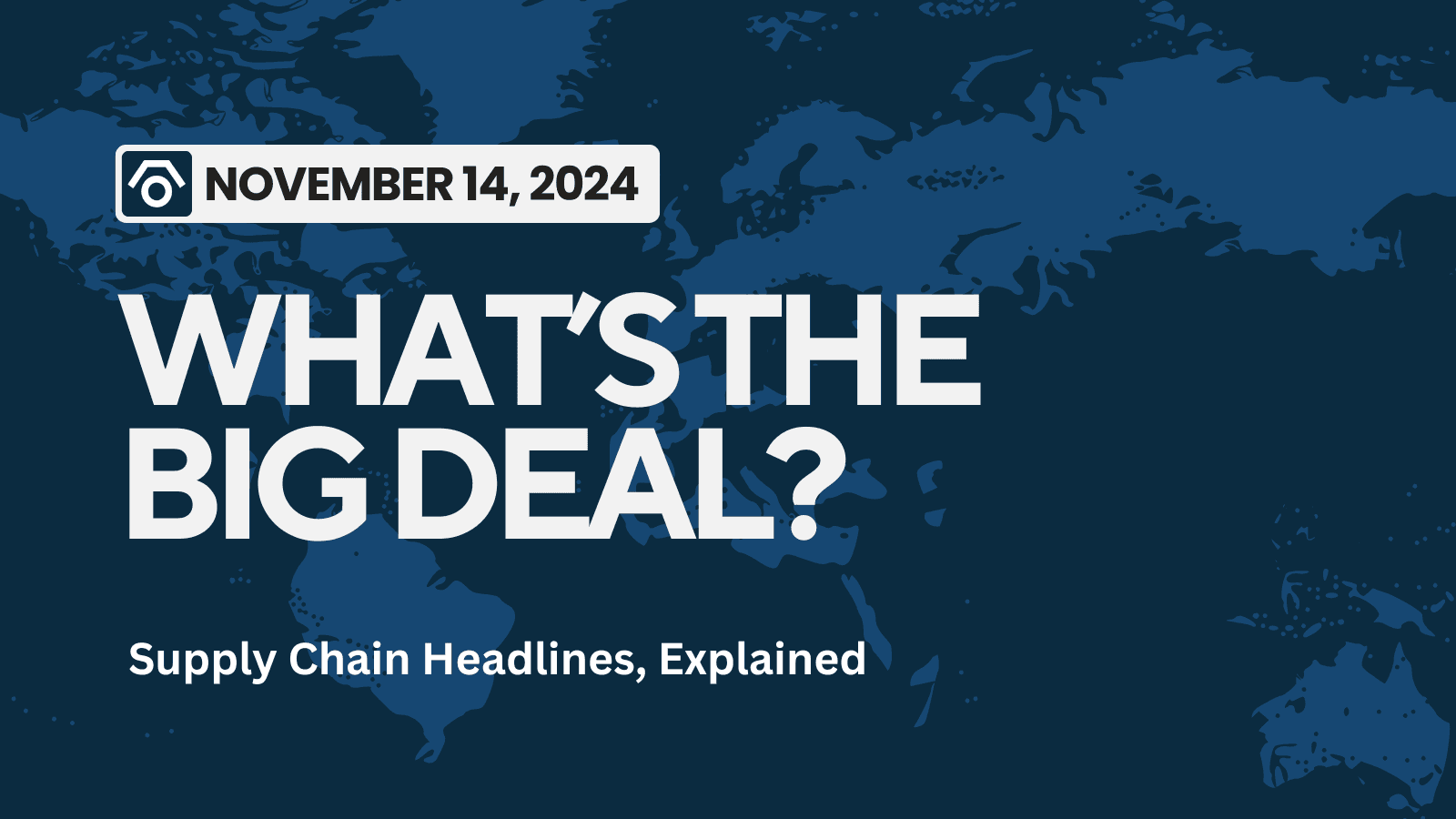Industry
What's the Big Deal? Nov 14th Supply Chain News
Trade policy plot twists, the EU going green, and will my designer bag cost more?

Abdul
·
Nov 15, 2024
·
8 min read

November 14th Supply Chain Highlights: Deals and Developments
What's the big deal?
'What's the big deal?' is our weekly roundup of supply chain news you need to know. We break down top headlines in the industry, what they mean for businesses and consumers, and most importantly— why it's a big deal.
Grab a coffee and let’s dive into the headlines this week:
Back to Tariffs? The U.S. Trade Policy Plot Twist
Going Green, One Regulation at a Time: The EU’s Deforestation Rule
Canada’s Port Strike: When Logistics Hits a Rocky Patch
Luxury Goods Face Tariff Trouble: Will My Designer Bag Cost More?
Asia’s Airlines are in a Pickle: Shortages are Grounding Flights
Digital Supply Chains: The Robots Are Coming, and It’s a Good Thing
1. Back to Tariffs? The U.S. Trade Policy Plot Twist
With a new administration transitioning into the Oval Office, supply chain managers are keeping a close eye on any potential changes in trade policy—especially the possibility of new tariffs. Last time this happened, we saw prices go up, sourcing strategies shift, and companies hustling to adapt. Now, as some restrictions on certain imports could be on the horizon, companies are getting creative: exploring reshoring (bringing production back home) or nearshoring (bringing it closer).
What’s the Big Deal? Imagine a team leader asking, “So, we source everything from one place, and now there’s a chance for trade changes... What’s next?” That’s the situation a lot of companies are in. The smart play? Stay flexible. Look into alternative suppliers, weigh the pros and cons of reshoring, and keep a close watch on any new developments in trade policy. In other words, it’s time for a solid Plan B (and maybe Plan C and D).
Read more: Business Insider
2. Going Green, One Regulation at a Time: The EU’s Deforestation Rule
The European Union isn’t playing around when it comes to sustainability. Its latest rule? Companies must ensure their products aren’t contributing to deforestation, which means tracking every material, ingredient, and supplier like a hawk. This impacts industries from food to luxury goods, essentially anyone who sources materials from regions with deforestation concerns. The compliance burden is heavy, but so is the environmental impact.
What’s the Big Deal? This isn’t just about saving trees; it’s about reshaping how supply chains operate. Keeping track of every supplier and source isn’t easy, but with consumers and regulators alike demanding sustainability, there’s no getting around it. The trick here? Embrace the tech. Companies can use blockchain to trace products, making sure every link in the chain is compliant (and eco-friendly). Plus, who doesn’t want to advertise that they’re a tree-hugging, earth-saving brand?
Read more: BNN Bloomberg
3. Canada’s Port Strike: When Logistics Hits a Rocky Patch
Let’s start with one of the biggest thorns in the side of North American logistics right now: the port strike in Canada. Several major Canadian ports, including those in Vancouver and Prince Rupert, have faced ongoing labor strikes, which has thrown a wrench into the supply chains not just in Canada but across North America. The workers are pushing for better pay and improved working conditions, but the real-world impact is gridlock at some of the continent’s busiest cargo entry points.
What’s the Big Deal? Canada’s ports handle massive volumes of imports and exports, particularly for industries like automotive, agriculture, and consumer goods. When ports go on strike, everything slows down. For companies relying on imports, this delay can mean stockouts, unhappy customers, and increased shipping costs as they look for ways around the logjam. To cope with these challenges, some companies are rerouting shipments through U.S. ports, which adds cost but keeps goods moving. Others are exploring rail options to reach the interior of Canada, though capacity is tight. The reality is that strikes like this highlight the importance of having a flexible, resilient supply chain that can pivot when the unexpected happens.
Read more: Supply Chain Dive
4. Asia’s Airlines are in a Pickle: Shortages are Grounding Flights
It turns out, airlines need quite a few nuts and bolts to keep those planes flying, and right now, parts are in short supply. Airlines in Asia are struggling with delays in aircraft maintenance because crucial parts are hard to get, and skilled labor is stretched thin. This isn’t your garden-variety supply chain delay; for airlines, if one part is missing, planes can’t fly. And since they can’t exactly duct-tape an engine together, a lot of flights are getting cut or delayed.
What’s the Big Deal? For airlines, timing is everything. Their supply chains are as tight as those tiny seats they squeeze us into. This disruption could lead to cancelled flights, more delays, and, yes, possibly higher ticket prices as airlines scramble to keep up. The takeaway? This is a wake-up call for the industry to stock up on essential parts and, just maybe, start diversifying where they get them from.
5. Luxury Goods Face Tariff Trouble (Will My Designer Bag Cost More?)
If the idea of tariffs on Chinese imports sounds alarming to supply chain folks, it’s nothing short of terrifying for the luxury goods industry. For a sector that’s dependent on very specific materials and craftsmanship—often sourced globally—new tariffs mean higher costs and potentially thinner margins. For luxury brands that pride themselves on exclusivity and quality, this is a big deal. And yes, this could mean higher price tags for consumers.
What’s the Big Deal? For brands that rely on specific materials or suppliers, tariffs are like a financial earthquake. Many of these companies are having to get creative. Do they pass the cost to consumers? (Gasp!) Do they shift production? Or, do they find cheaper alternatives? While price hikes aren’t great for anyone’s wallet, brands that adapt quickly and maybe invest in smarter, more cost-effective sourcing could avoid taking too big a hit. Plus, it might just be the nudge some companies need to find suppliers a little closer to home.
Read more: Financial Post
6. Digital Supply Chains: The Robots Are Coming, and It’s a Good Thing
Digital everything! AI! Robots! Supply chain managers are getting their hands on some of the coolest tools around, and the trend is only getting bigger. Today’s supply chains are loaded with tech that improves visibility, optimizes routes, predicts demand, and more. AI-driven automation and analytics mean companies are becoming more efficient and can react faster than ever if something goes wrong. This level of tech adoption is especially crucial for shippers and carriers, who deal with thousands of moving parts (literally and figuratively) every day.
What’s the Big Deal? Imagine a world where you don’t just guess when the next shipment will arrive—you know, down to the minute. That’s what today’s supply chain tech makes possible. Companies investing in this tech aren’t just ahead of the curve; they’re setting themselves up to avoid a lot of the headaches that come with traditional, slower supply chains. This isn’t just future-proofing—it’s like getting a crystal ball that helps companies make the right call, every time.
Wilson’s Take: Bring on the Robots!
Cartage’s AI logistics coordinator Wilson has a strong opinion on the rise of digital supply chains—it’s his family after all.
His view? The more tech in the supply chain, the better: “AI isn’t just coming; it’s already here, and ready to help. I say bring on the robots and AI (not bias at all)—let’s create a world where speed, accuracy, and insight aren’t just goals, but everyday standards.”
So… How Do We Keep Up with All This?
If there’s one thing all these trends make clear, it’s that the supply chain game is changing. And in a big way. So, what can companies do to keep up without losing their minds?
Stay Flexible: Whether it’s tariffs, part shortages, or new regulations, companies need to build flexibility into their supply chain strategies. Think multiple suppliers, new regions, and having a Plan B at the ready.
Go Digital: Investing in tech isn’t just a good idea; it’s essential. AI, IoT, and real-time data help companies avoid problems and keep things moving smoothly. And if you’re not using blockchain to trace products yet, now’s the time to get on board.
Embrace Sustainability: Green isn’t going anywhere. With consumers, governments, and even investors all demanding sustainable practices, companies need to treat sustainability as a key part of their strategy. It’s not just good for the planet; it’s good for business.
Be Ready to Pivot: In a world where political and economic changes can shake up an entire industry, agility is king. Companies that can pivot quickly when something shifts—whether it’s a new regulation or a trade restriction—are the ones that come out on top.
Supply chain might not have always been glamorous, but these days, it’s the place to be. Whether we’re talking about saving the planet, keeping those luxury handbags on shelves, or making sure flights aren’t canceled, it’s clear that supply chain is shaping the future. And who knows? Maybe one day we’ll even look back and say, “Remember when we had to wait weeks for stuff? Now it’s all on-demand.” Until then, buckle up, because there’s always something new on the horizon in supply chain.
Put your freight operations on autopilot.
Try AI-managed transport today







